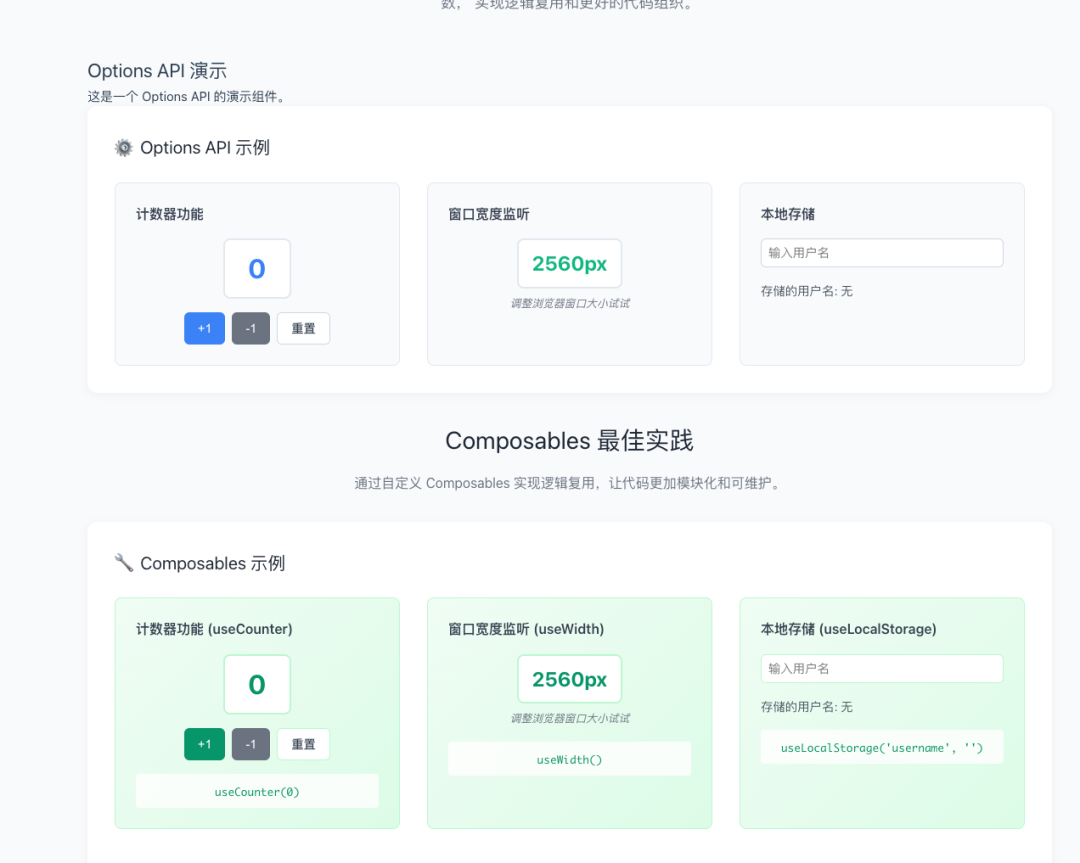在现代前端开发的演进过程中,代码的可重用性、模块化和可维护性一直是开发者追求的核心目标。Vue 3 引入的 Composables(组合式函数)为我们提供了一种革命性的方式来实现这些目标。本章将深入探讨 Composables 的核心概念、设计理念、实际应用和最佳实践,帮助您掌握这一强大的开发模式。
Composables 不仅仅是一个技术特性,它代表了一种全新的思维方式 - 从传统的选项式组织转向函数式组合。这种转变让我们能够以更加灵活、直观的方式构建复杂的应用程序。
学习目标
通过本章的学习,您将能够:
-
深入理解 Options API 与 Composition API 的本质区别和各自优势
-
熟练掌握 Composition API 的核心概念和使用方法
-
独立创建 高质量、可重用的 Composables 函数
-
灵活运用 Composables 的组合模式解决复杂业务场景
-
遵循最佳实践 编写可维护、可测试的组合式函数
-
理解设计原则 掌握 Composables 的设计哲学和架构思想
-
解决实际问题 运用 Composables 优化现有项目结构
从 Options API 到 Composition API 的演进历程
Options API 的时代背景与设计理念
在 Vue 3 引入 Composition API 之前,开发者主要依赖 Options API 来组织组件逻辑。Options API 通过将组件的不同方面(响应式数据、生命周期方法、计算属性、侦听器等)定义在特定的选项中来工作,如下所示:

go
<!-- Template -->
<template>
<div class="my-component">
<h2>{{ title }}</h2>
<p>Count: {{ count }}</p>
<p>Double Count: {{ doubleCount }}</p>
<button @click="increment">Increment</button>
<button @click="reset">Reset</button>
</div>
</template>
<script>
export default {
name: "MyComponent",
props: {
// 组件属性定义
initialCount: {
type: Number,
default: 0
}
},
data() {
// 响应式数据
return {
count: this.initialCount,
title: 'Vue Component',
message: 'Hello Vue'
}
},
computed: {
// 计算属性
doubleCount() {
return this.count * 2
},
displayMessage() {
return `${this.message} - Count: ${this.count}`
}
},
watch: {
// 侦听器
count(newVal, oldVal) {
console.log(`Count changed from ${oldVal} to ${newVal}`)
if (newVal > 10) {
this.message = 'Count is getting high!'
}
}
},
methods: {
// 方法
increment() {
this.count++
},
reset() {
this.count = this.initialCount
},
updateTitle(newTitle) {
this.title = newTitle
}
},
created() {
// 生命周期钩子
console.log('Component created')
this.initializeComponent()
},
mounted() {
console.log('Component mounted')
},
// 其他生命周期钩子...
}
</script>
<!-- Styles -->
<style scoped>
.my-component {
padding: 20px;
border: 1px solid #ccc;
}
</style>这种方法在其设计初期很好地服务了 Vue 社区,并且在 Vue 3 中仍然完全可用。Options API 的优点包括:
-
结构清晰:每种类型的逻辑都有明确的位置
-
学习曲线平缓:对于初学者来说容易理解
-
约定明确:团队成员都知道在哪里找到特定类型的代码
Options API 的深层局限性
然而,随着应用程序变得越来越复杂,Options API 的一些根本性局限开始显现:
1. 逻辑分散问题(Logic Fragmentation)
在大型组件中,相关的逻辑往往被强制分散在不同的选项中。让我们通过一个实际的例子来理解这个问题:
go
<template>
<div class="user-dashboard">
<!-- 用户信息区域 -->
<div class="user-info">
<h2>{{ user.name }}</h2>
<p>{{ user.email }}</p>
<button @click="refreshUserData">Refresh</button>
</div>
<!-- 搜索区域 -->
<div class="search-section">
<input v-model="searchQuery" placeholder="Search users...">
<div class="filters">
<select v-model="selectedRole">
<option value="">All Roles</option>
<option value="admin">Admin</option>
<option value="user">User</option>
</select>
</div>
</div>
<!-- 用户列表 -->
<div class="user-list">
<div v-for="user in filteredUsers" :key="user.id" class="user-item">
{{ user.name }} - {{ user.role }}
</div>
</div>
<!-- 分页 -->
<div class="pagination">
<button @click="previousPage" :disabled="currentPage === 1">Previous</button>
<span>Page {{ currentPage }} of {{ totalPages }}</span>
<button @click="nextPage" :disabled="currentPage === totalPages">Next</button>
</div>
</div>
</template>
<script>
export default {
name: 'UserDashboard',
data() {
return {
// 用户相关数据
user: null,
userLoading: false,
// 搜索相关数据
searchQuery: '',
selectedRole: '',
// 用户列表相关数据
users: [],
usersLoading: false,
// 分页相关数据
currentPage: 1,
pageSize: 10,
totalUsers: 0
}
},
computed: {
// 搜索相关计算属性
filteredUsers() {
return this.users.filter(user => {
const matchesSearch = user.name.toLowerCase().includes(this.searchQuery.toLowerCase())
const matchesRole = !this.selectedRole || user.role === this.selectedRole
return matchesSearch && matchesRole
})
},
// 分页相关计算属性
totalPages() {
return Math.ceil(this.totalUsers / this.pageSize)
},
paginatedUsers() {
const start = (this.currentPage - 1) * this.pageSize
const end = start + this.pageSize
return this.filteredUsers.slice(start, end)
}
},
watch: {
// 搜索相关侦听器
searchQuery() {
this.currentPage = 1 // 重置到第一页
this.debouncedSearch()
},
selectedRole() {
this.currentPage = 1
this.fetchUsers()
},
// 分页相关侦听器
currentPage() {
this.fetchUsers()
}
},
methods: {
// 用户相关方法
async fetchUserData() {
this.userLoading = true
try {
this.user = await api.getCurrentUser()
} catch (error) {
console.error('Failed to fetch user data:', error)
} finally {
this.userLoading = false
}
},
refreshUserData() {
this.fetchUserData()
},
// 搜索相关方法
debouncedSearch: debounce(function() {
this.fetchUsers()
}, 300),
// 用户列表相关方法
async fetchUsers() {
this.usersLoading = true
try {
const response = await api.getUsers({
page: this.currentPage,
pageSize: this.pageSize,
search: this.searchQuery,
role: this.selectedRole
})
this.users = response.data
this.totalUsers = response.total
} catch (error) {
console.error('Failed to fetch users:', error)
} finally {
this.usersLoading = false
}
},
// 分页相关方法
nextPage() {
if (this.currentPage < this.totalPages) {
this.currentPage++
}
},
previousPage() {
if (this.currentPage > 1) {
this.currentPage--
}
}
},
created() {
// 初始化所有功能
this.fetchUserData()
this.fetchUsers()
}
}
</script>在这个例子中,我们可以清楚地看到逻辑分散的问题:
-
用户信息功能 :数据分散在
data(user, userLoading),方法分散在methods(fetchUserData, refreshUserData),初始化在created -
搜索功能 :数据在
data(searchQuery, selectedRole),计算属性在computed(filteredUsers),侦听器在watch,方法在methods -
分页功能:数据、计算属性、方法都分散在各自的选项中
这种分散使得:
-
理解单个功能需要在多个选项间跳转
-
修改功能时容易遗漏相关代码
-
代码审查变得困难
-
新团队成员难以快速理解代码结构
2. 逻辑复用的困难
在 Options API 中,复用逻辑主要通过以下方式实现,但都存在明显的问题:
Mixins 的问题:
go
// userMixin.js
exportconst userMixin = {
data() {
return {
user: null,
loading: false
}
},
methods: {
async fetchUser() {
this.loading = true
try {
this.user = await api.getUser()
} finally {
this.loading = false
}
}
},
created() {
this.fetchUser()
}
}
// searchMixin.js
exportconst searchMixin = {
data() {
return {
query: '',
results: []
}
},
methods: {
search() {
// 搜索逻辑
}
}
}
// 在组件中使用
exportdefault {
mixins: [userMixin, searchMixin],
// 可能出现命名冲突,难以追踪数据来源
}Mixins 的问题包括:
-
命名冲突风险:多个 mixins 可能有相同的属性或方法名
-
依赖关系不明确:难以知道某个属性来自哪个 mixin
-
隐式依赖:mixin 之间可能有隐式的依赖关系
-
难以调试:错误堆栈追踪变得复杂